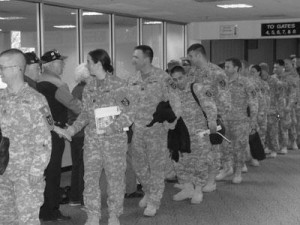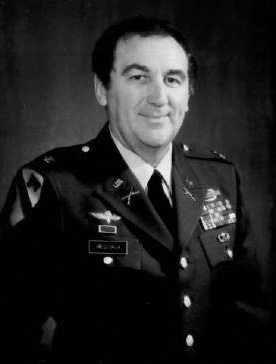Edward J. Herlihy Citizenship Award
Edward J. Herlihy Citizenship Award recognizes an individual (citizen or veteran) for significant work preserving the legacy of America’s service members.
The 2009 Award was presented to The Maine Troop Greeters.
 It all began on a winter morning in 1991, after a large and spirited group of citizens drove to Bangor International Airport to welcome home planeloads of returning Troops from Operation Desert Storm. On that first of many days to follow, Kevin Tillman, an Army Sergeant with the 82nd Airborne Division, borrowed a high school student’s saxophone during a refueling stop and delivered a spine-tingling rendition of “The Star Spangled Banner”. By nightfall on March 8, 1991, Tillman’s performance had been broadcast around the globe, thrusting Bangor, Maine and the volunteers later known as the Maine Troop Greeters into the limelight.
It all began on a winter morning in 1991, after a large and spirited group of citizens drove to Bangor International Airport to welcome home planeloads of returning Troops from Operation Desert Storm. On that first of many days to follow, Kevin Tillman, an Army Sergeant with the 82nd Airborne Division, borrowed a high school student’s saxophone during a refueling stop and delivered a spine-tingling rendition of “The Star Spangled Banner”. By nightfall on March 8, 1991, Tillman’s performance had been broadcast around the globe, thrusting Bangor, Maine and the volunteers later known as the Maine Troop Greeters into the limelight.
Another war and more than half a million troops later, the airport greetings continue. No matter the hour, members of all branches of the U.S. military and our allies are assured of a handshake, use of a free cell phone and a cookie as they pass through the city’s airport. Many are headed to and from Iraq, as part of Operation Iraqi Freedom, as well as other hot spots around the globe.
The Maine Troop Greeters were officially incorporated as a registered non-profit organization in 2008. The group agreed on this guiding principle: “The mission of the Maine Troop Greeters is to express the Nation’s (and our) gratitude and appreciation to the Troops, for those going overseas for a safe return and for those returning for a joyful homecoming and to make their (hopefully brief) stay in Bangor as comfortable and pleasant as possible.”
The 2008 award was given to Colonel Cyril “Rick†Rescorla, USA (Ret).

September 11, 2001. A day Americans will never forget. The destruction of the World Trade Center at the hands of bloodthirsty terrorists is an image forever burned into our minds.
Yet despite the horror, the nation found a newfound resolve. Inside the buildings, selfless acts of heroism were displayed that were so profound, had they been witnessed on a field of battle they would have merited all the glory given to those who have received the Medal of Honor.
Among the heroes, one man’s story stands out. He was a hero before, in the jungles of Vietnam, under a legendary commander in one of the toughest fights in U.S. history.
Ia Drang Valley, Central Highlands of South Vietnam. November 14, 1965. Elements of the 1st Battalion, 7th Cavalry touch down in a clearing dubbed Landing Zone X-Ray. Their mission: to find and kill the enemy forces suspected to be in the area. They would not have far to look, as three battalions of North Vietnamese sat waiting on the nearby Chu Pong Mountain, eager to get a shot at taking on the Americans.
Fighting quickly erupted, as then-Lt. Col. Hal Moore built a defensive perimeter around the edge of the landing zone. The next morning, shortly after 9:00 AM, men from the 2nd Battalion 7th Cavalry arrived at X-Ray to reinforce the soldiers under Lt. Col. Moore. Among them was one of the few soldiers on the battlefield to have combat experience, a platoon leader in Bravo Company by the name of Rick Rescorla.
A native of Cornwall, England, Rick Rescorla grew up idolizing the men of the U.S. 29th Infantry Division stationed near his hometown. He would join the British Army, fighting the Communist insurgency in Cyprus, and later served with the Northern Rhodesia Police. He eventually moved to the United States, where he joined the Army and was made a platoon leader in the 2nd Battalion, 7th Cavalry Regiment, 1st Cavalry Division (Airmobile).
At LZ X-Ray, the situation was dire. The vastly outnumbered Americans were nearly surrounded by well-trained and motivated North Vietnamese soldiers. Yet Rescorla’s confidence never wavered. He walked among his men’s foxholes, singing Cornish songs, including a version of the famed old military march, Men of Harlech, and leading cheers to raise morale.
A fellow soldier, Larry Gwin, said, “I saw Rick Rescorla come swaggering into our lines with a smile on his face, an M-79 on his shoulder, his M-16 in one hand, saying ‘Good, good, good! I hope they hit us with everything they’ve got tonight—we’ll wipe them up!’ His spirit was catching. The enemy must have thought an entire battalion was coming to help us, because of all our screaming and yelling.â€
The men of the 1st Cav held out at X-Ray, eventually beating back the tremendous North Vietnamese onslaught, due in no small part to the leadership of Rick Rescorla. He was a rock on the battlefield, steady and strong, and would be awarded the Silver and Bronze Stars along with the Purple Heart. Hal Moore called him “The best platoon leader I ever saw,†and it was Rick Rescorla’s photo that adorned the cover of General Moore and Joseph Galloway’s classic account of Ia Drang, We Were Soldiers Once…and Young.
Rick Rescorla returned to the States and retired into civilian life. Several years later he took charge of security for Morgan Stanley Dean Witter, located in the South Tower of the World Trade Center in New York City. In 1992, Rescorla warned the Port Authority, the owners of the World Trade Center, of the danger of a potential terrorist attack which might bring the buildings down by planting a truck laden with explosives next to one of the load-bearing columns in the basement. Yet he was ignored, and in 1993, Islamic terrorists detonated such a bomb. While it failed to bring the towers down, the attack killed six and injured over 1,000. It also proved Rescorla’s fears true that the twin towers were already a major terrorist target. He was there that day, and was instrumental in the evacuation, being the last man to leave.
Recognizing that this would not be the last attempt to bring down the buildings, Rescorla urged his company to move. He believed they were too ripe a target for such truck bombings or even cargo planes loaded with explosives or chemical weapons en route from the Middle East. However, Morgan Stanley’s lease did not end until 2005, so he was told such a move would not be possible.
Under the circumstances, he did what he could. He installed generators and lighting in the stairwells, and drilled the employees twice a year, forcing them to walk all the way down the stairs of one of the tallest skyscrapers in the world, earning him more than his share of grumbling and ridicule. His preparation, however, would pay off in ways nobody could ever imagine.
8:46 AM on September 11, 2001. American Airlines Flight 11 crashes into the North Tower of the World Trade Center. Over the intercom in the South Tower, authorities told everyone to stay put – they were safe where they were. Rescorla would have none of it, and immediately started evacuating Morgan Stanley employees.
Rick Rescorla was everywhere that morning – reported to have been seen in the stairwell from the 10th to the 72nd floors, calmly and confidently encouraging his terrified co-workers down the stairs to safety. “Be proud to be an American – everybody will be talking about you tomorrow,†he told them over a bullhorn. And as in Vietnam over 35 years earlier, he began to sing: God Bless America and defiant Cornish songs, once again including his adaptation of Men of Harlech.
9:03 AM. United Airlines Flight 175 smashes into the South Tower. Undeterred, Rescorla continued the evacuation. He called his wife, Susan, telling her he was getting his people out. His last words to her before hanging up were, “You made my life.â€
By the time the second plane had hit the South Tower, Rescorla had evacuated most of Morgan Stanley’s 2700 employees. Yet, despite this, he rushed back inside along with three of his deputies. When told that he had to leave, he replied, “As soon as I make sure everyone else is out.â€
9:59 AM. The South Tower collapses. Twenty-nine minutes later, the North Tower fell. Over 2,700 people were killed in the disaster. It should have been more. If not for the planning and leadership of Rick Rescorla, it is certain that many of Morgan Stanley’s 2,700 employees would have died when the South Tower collapsed. Instead, only six were killed – including Rick Rescorla and his deputies. He was last seen rushing up the 10th floor stairwell of the South Tower, determined to once again be the last man out.
Rick Rescorla’s story of valor and sacrifice in our nation’s darkest hour is one that every American should know. Many have worked to make this the case. In his memory, Susan Rescorla created the Richard C. Rescorla Memorial Foundation, and his story was told by James Stewart in the best-selling book Heart of A Soldier. And to date, nearly 31,000 individuals have signed a petition for Rick to receive our nation’s highest civilian award, the Presidential Medal of Freedom.
For his heroism, honor, and nobility, and for being responsible for saving the lives of nearly 3,000 people, the American Veterans Center is proud to help share Rick Rescorla’s story and to salute him as the recipient of the 2008 Edward J. Herlihy Citizenship Award.
no images were found










